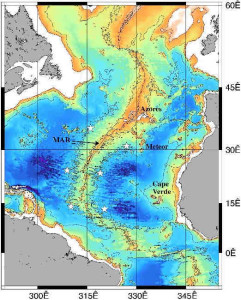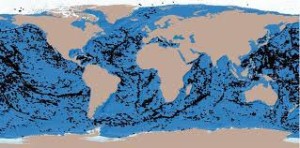Bruce Heezen
Heezen, Bruce *
Bruce Charles Heezen (1924-1977) was an American oceanographer and geologist who led the Columbia University team that mapped the Mid-Atlantic Ridge in the 1940s and ’50s. They also  discovered and named some seamounts and confirmed that there was evidence that at least the summits had been above water and existed as islands sometime during the past 12,000 years. Presumably, this was the result of the lower ocean levels during the last Ice Age.
discovered and named some seamounts and confirmed that there was evidence that at least the summits had been above water and existed as islands sometime during the past 12,000 years. Presumably, this was the result of the lower ocean levels during the last Ice Age.
Supporters of the theory of Atlantis being located in the Atlantic believe that the discoveries of Heezen, Maurice Ewing, and others support their contention. R. Cedric Leonard(a) and Carl Martin(b) are enthusiastic members of this school of thought.
It was Heezen, along with his colleague, Dragoslav Ninkovich, who provided the first firm evidence that the Late Bronze Age eruption of Thera, directly affected the eastern part of Crete through ash fall-out in a 1965 paper[1151].
(a) https://web.archive.org/web/20161209175953/https://www.atlantisquest.com/Geology.html
(b) https://ezinearticles.com/?Atlantis-through-Science&id=42810 (link broken)
Seamounts *
Seamounts are mountains that rise from the ocean floor but do not reach the water’s surface. However, during the last Ice Age when the level of the oceans were much lower a considerable number of these seamounts would have existed as islands that in many cases would have been quite substantial in area. Many of the thousands of seamounts around the world are of volcanic origin.
The Atlantic is home to many named seamounts, three of which are called Atlantis, Cruiser and Great Meteor. Bruce Heezen et al published a short paper in 1954 describing these flat-topped features(k).
The Ampere and Josephine Seamounts, 450 miles west of Gibraltar were investigated by Soviet oceanographers, including Andrei Aksyonov, in 1970s (f)(j). On examination of their underwater photographs, they discerned what appeared to be ‘walls, stairs and other artificial stonework’ at a depth of around 200 feet, far less than the drop in ocean levels that occurred during the Ice Age. Egerton Sykes was convinced that these reports and associated photos revealed remnants of Atlantis or one of its colonies. Alexander Gorodnitsky also chose the vicinity of the Josephine and Ampere Seamounts as the site of Atlantis(j).
Josephine Seamount was claimed once again as the site of Atlantis by ‘Paulo Riven’ in 2003(b).
However, such claims must be treated with great caution until further corroboration is received. One Internet commentator has suggested(a) that the Amperes/Gettysburg Seamounts were once the location of a substantial island, containing Atlantis, which had been destroyed by asteroidal showers, combined with a nearby geological fracture. This same writer dates this disaster to 6482 BC.
Appropriately there is an Atlantis Seamount with its ‘Lost City’ hydrovents, where recent research(c) has drilled for samples of the lowest level of the Earth’s crust, which rests on the mantle.
Horseshoe Seamounts, is an extensive submerged chain of mountains north of the island of Madeira, in the Atlantic, opposite Gibraltar. Frank Joseph suggests[102] that the 6,000 sq. miles of this seamount was large enough to contain Plato’s Atlantis. Joseph has also written an article(g) on the Russian claims of discovering human artifacts on Ampere in the 1970’s. This should be read in conjunction with a short piece from Jason Colavito(h).
Another possible candidate was the Great Meteor Seamount, which was apparently shown on a 1707 map by French cartographer, Guillaume Delisle, as Saint Brendan’s Isle(e).
Paul Dunbavin has added a paper(i) on his website in which he discusses the Ormonde and Gettysburg Seamounts, which are opposite the Strait of Gibraltar, and their possible relevance to the Atlantis story, as suggested by some. Dunbavin concludes that “It should be apparent that even if these two islets did appear above the sea during the Holocene then they cannot have been Atlantis. They are simply too small to hold all the features described.”
The Azores, Canaries and Madeiras, in the Eastern Atlantic would have had larger landmasses exposed before the end of the last Ice Age because of the lower ocean levels. These archipelagos, together with seamounts, currently submerged, would have offered a substantial area of dry land, in a hospitable climate, on which a civilisation could have developed and flourished.
Another suggested connection between seamounts and Atlantis is made on a website(d) which nominates Dacia Seamount as its location with a series of interesting images and a lot of speculation.
(a) https://en.wikipedia.org/wiki/Talk:Atlantis/Archive_1
(b) https://tribesofatlantis.blogspot.ie/p/atlantean-chronos-by-paulo-riven.html
(d) https://www.flickriver.com/photos/10749411@N03/sets/72157625118289098/
(e) Redirecting (journalofthebizarre.blogspot.com)
(f) https://trove.nla.gov.au/ndp/del/article/110939505?searchTerm=Atlantis discovered&searchLimits=
(h) https://www.jasoncolavito.com/blog/the-soviet-search-for-lemuria-and-atlantis
(i) https://www.third-millennium.co.uk/submerged-islands-gibraltar-strait
(j) http://atlantisonline.smfforfree2.com/index.php/topic,13305.0.html
(k) Bulletin of the Geological Society of America- Vol.65, 1954
Mid-Atlantic Ridge
 The Mid–Atlantic Ridge (MAR)(a) was first physically located in 1872 by Sir John Murray (1841-1914), the celebrated oceanographer while investigating a route for a transatlantic telegraph cable aboard HMS Challenger. John Thomas Short in The North Americans of Antiquity [1192.503] notes “that a member of the Challenger staff, in a lecture delivered in London soon after the termination of the expedition, expressed the fullest confidence thatof the great submarine plateau is the remains of the ‘Lost Atlantis’.” (f)
The Mid–Atlantic Ridge (MAR)(a) was first physically located in 1872 by Sir John Murray (1841-1914), the celebrated oceanographer while investigating a route for a transatlantic telegraph cable aboard HMS Challenger. John Thomas Short in The North Americans of Antiquity [1192.503] notes “that a member of the Challenger staff, in a lecture delivered in London soon after the termination of the expedition, expressed the fullest confidence thatof the great submarine plateau is the remains of the ‘Lost Atlantis’.” (f)
>Within five years of its discovery Scientific American was promoting the MAR as the site of Atlantis. A short article in the edition of July 28 1877(f) ended with the following comment “At any rate it must be admitted that Atlantis has existed as a substantial reality.” This claim was endorsed a year later in the edition of August 24 1878(i).<
Ignatius Donnelly used the discovery of the Ridge to justify his Atlantic location for Atlantis and the publication of Atlantis just four years later.
An overview of the surveying of the MAR during the first half of the 20th century was published in 2014(e).
However, the MAR was not explored extensively until 1947 and 1948 by a team from Columbia University led by Bruce Heezen in a research vessel named Atlantis. Many commentators claimed that there is no possibility of a ‘continent’ submerged in the Atlantic. However, leaving aside whether Plato referred to Atlantis as a continent, the most cursory study of a bathymetric chart of the region shows several extensive areas that would have been dry land before the melting of the glaciers at the end of the last Ice Age. One of the most obvious is the Azores whose location opposite the most favoured location for the Pillars of Heracles has been seized upon as evidence for considering it as a possible site of Atlantis.
Christian O’Brien expanded on this in his book, The Shining Ones, an extract from which is available online(c). Andrew Collins’ critical comments on O’Brien’s theories can also be read online(d).
Emmet Sweeney is another modern commentator who argues in Atlantis: The Evidence of Science [700] that at least parts of the MAR were above water at a time more recent than generally accepted. According to Sweeney, this exposed land included what we now identify as the Azores and provided a home for Atlantis.
Several writers, such as R. Cedric Leonard, have chosen the Mid-Atlantic Ridge location for Atlantis. Charles Hapgood opted for the Rocks of St. Peter and St. Paul on the MAR, about 1000 miles from the mouth of the Orinoco in Venezuela, as the site of Plato’s famous island.
An extensive contribution by Carolyn Silver supporting the MAR as the location of Atlantis is available online(b).
In 2021 a wealth of new data added further important information regarding the MAR and plate tectonics(g)(h).
(a) https://www.youtube.com/watch?v=s6JZ4n75eEA&NR=1
(b) https://atlantisonline.smfforfree2.com/index.php/topic,10182.0/wap2.html
(c) https://www.goldenageproject.org.uk/342proof.php
(d) https://www.andrewcollins.com/page/interactive/midatlan.htm
(f) Scientific American, July 28, 1877 https://archive.org/details/scientific-american-1877-07-28/page/n1
(g) https://eos.org/articles/a-new-understanding-of-the-mid-atlantic-ridge-and-plate-tectonics
(h) https://www.southampton.ac.uk/news/2021/01/atlantic-plate-tectonics.page

